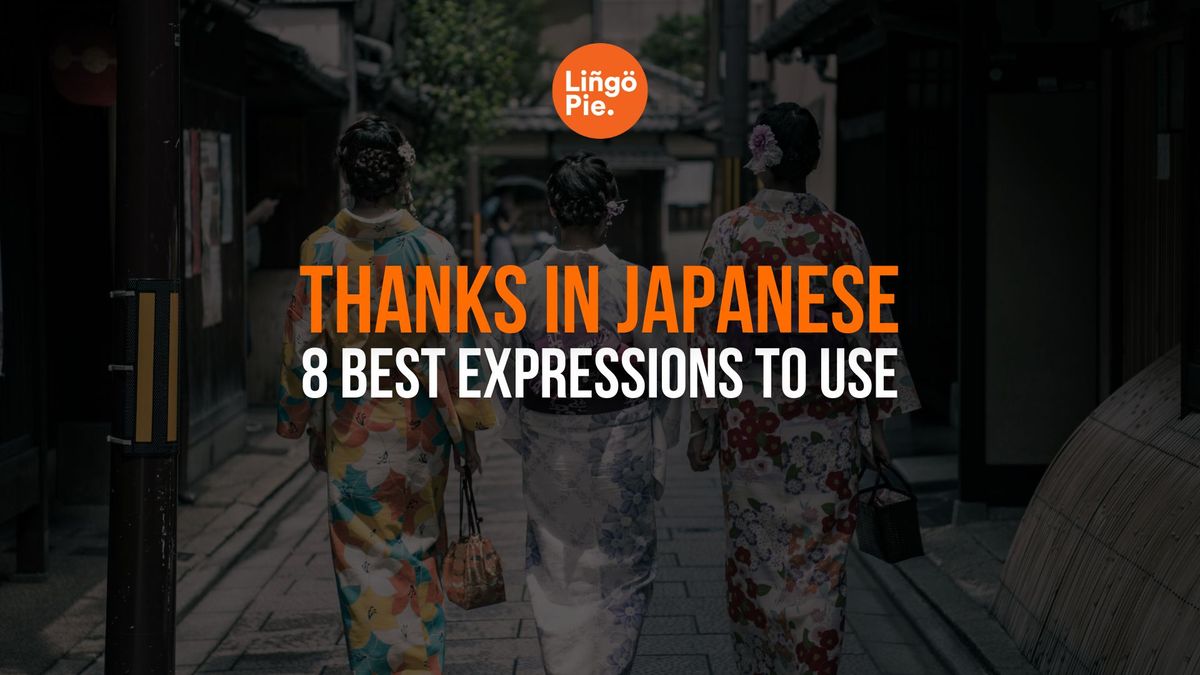Learning to say thank you in Japanese isn't just about knowing a single phrase - it's about mastering a key part of Japanese culture. Whether you're planning a trip to Tokyo, watching anime without subtitles, or just starting your Japanese learning journey, knowing different ways to express gratitude can take your conversations from awkward to smooth in seconds.
In this post, I'll show you 8 practical ways to say thank you in Japanese that you can start using right away. You'll learn when to use each phrase, how to pronounce them correctly, and the cultural context behind them - because saying thanks in the Japanese language is about much more than just words.

How To Say Thank You In Japanese
1. ありがとう (Arigatou)
"Arigatou" is the standard, everyday way to say thank you in Japanese that you've probably heard in anime or J-pop songs. This simple expression works great with friends, classmates, and in casual settings. Japanese people use this relaxed form when the situation doesn't call for extra formality, similar to how we say "thanks" in English.
Pronunciation: ah-ree-gah-toh
When to use it:
- With friends and people your age
- In casual settings like cafés or shops
- For small favors or everyday situations
While arigatou works in many situations, it can seem too casual in professional or formal settings. Japanese people consider the relationship between speakers when choosing how to express gratitude.
2. ありがとうございます (Arigatou Gozaimasu)
"Arigatou gozaimasu" adds a layer of politeness to the basic thank you by adding the "gozaimasu”. The addition of "gozaimasu" transforms a casual thanks into something appropriate for strangers, people older than you, or anyone in a service position.
Pronunciation: ah-ree-gah-toh goh-zah-ee-mas
When to use it:
- With strangers, teachers, or elders
- In stores, restaurants, and business settings
- When receiving service or help from someone
Adding ございます transforms the casual ありがとう into a phrase suitable for almost any situation where politeness matters. This is the standard "thank you" you'll hear in restaurants, stores, and offices throughout Japan.

3. どうもありがとう (Doumo Arigatou)
"Doumo arigatou" kicks your gratitude up a notch by adding "doumo" (meaning "very much") to the basic thanks. This middle-ground phrase works when you want to show more appreciation than a simple "arigatou" but don't need the full formal version. Japanese friends use this when someone has done them a favor that deserves special recognition—like helping them move furniture or sharing class notes.
Pronunciation: doh-moh ah-ree-gah-toh
When to use it:
- When someone has done you a significant favor
- To express deeper appreciation to friends or peers
- When a simple "arigatou" doesn't quite cover it
This phrase sits between casual and formal, perfect for when you want to show more gratitude without getting too formal. Japanese people often use this phrase when they want to show more gratitude than a simple ありがとう but are still in a relatively casual setting.
4. どうもありがとうございます (Doumo Arigatou Gozaimasu)
"Doumo arigatou gozaimasu" combines all elements to create the most complete, formal thank you in everyday Japanese. This phrase shows deep appreciation and respect. Japanese people use this when someone has done something significant for them, especially in professional settings or with people they don't know well.
This way of saying thanks in Japanese is often accompanied by a bow to show sincerity. Using this form correctly signals that you understand Japanese social customs and care enough to use the proper level of politeness.
Pronunciation: doh-moh ah-ree-gah-toh goh-zah-ee-mas
When to use it:
- In formal or business settings
- When someone has gone out of their way for you
- To show deep appreciation to someone you respect
Many Japanese people accompany this phrase with a bow to show sincere gratitude. The deeper the bow, the more respect and appreciation you're showing.

5. どうも (Doumo)
"Doumo" on its own works as a quick, casual "thanks" in Japanese. This shortened version is perfect for small gestures or brief interactions. You'll hear young Japanese people use this all the time in coffee shops, when receiving change at stores, or for small courtesies among friends.
Pronunciation: doh-moh
When to use it:
- For very small gestures or quick interactions
- With friends in casual settings
- When you want to be brief but still polite
While casual, it's not rude when used appropriately. Think of it as the Japanese equivalent of "thanks" versus "thank you." Don't use this with teachers, elders, or in business settings - it can come across as too casual or even dismissive.
6. すみません (Sumimasen)
When someone helps you, Japanese people often feel they've caused trouble or inconvenience, so they express both thanks and apology simultaneously. You'll hear this used when someone holds a door, gives directions, or makes an effort on your behalf. The word recognizes both the help you received and acknowledges the other person's effort, showing consideration for others that's central to Japanese social interactions.
Pronunciation: soo-mee-mah-sen
When to use it:
- When someone has been inconvenienced for your sake
- When you're both grateful and apologetic
- In situations where someone went out of their way for you
This phrase reflects the Japanese cultural concept of not wanting to trouble others. It acknowledges both the help you received and the effort someone made for you.

7. ありがとうございました (Arigatou Gozaimashita)
"Arigatou gozaimashita" is the past tense version of the polite thank you, used specifically after something has been completed. This form recognizes that a service or favor has finished, and you're expressing gratitude for what's already been done. Japanese people use this when leaving restaurants, at the end of appointments, or after receiving completed help.
Pronunciation: ah-ree-gah-toh goh-zah-ee-mash-ta
When to use it:
- At the end of a service (like after a meal or haircut)
- After someone has finished helping you
- When leaving a store, restaurant, or office
The "ta" ending indicates past tense in Japanese, showing that you're thanking someone for something that's already complete.
8. サンキュー (Sankyu)
"Sankyu" is the Japanese pronunciation of the English "thank you," making it a fun, modern slang term. Young Japanese people use this casual phrase among close friends, especially in urban areas and among those who enjoy Western influences. It has a cool, trendy vibe but would sound strange in formal settings or with older generations.
Pronunciation: san-kyuu
When to use it:
- Only with close friends, especially younger people
- In very casual, relaxed settings
- When you want to sound cool or trendy
Japanese has many English loan words, and this is one that's been fully adopted into casual speech. Just note that using this with teachers, older people, or in business settings would be considered inappropriate and potentially disrespectful.
- 16+ Crazy Japanese Curse Words And Expressions (With Context)
- 12 Japanese Anime for Kids That Will Make You Master Japanese
- 26+ Crazy Cute Japanese Words Every Beginner Should Know
Japanese Culture Of Showing Thanks
In Japanese culture, actions often speak louder than words. Here are two important non-verbal ways to express thanks:
Bowing
Bowing is a crucial part of Japanese etiquette. When saying thank you:
- For casual thanks: A slight nod or 15-degree bow
- For more formal situations: A 30-degree bow
- For deep gratitude: A 45-degree bow
Keep your back straight and, if you're a woman, you can place your hands in front of you. Men typically keep their arms at their sides.
Gift-Giving
Small gifts are a common way to express gratitude in Japan:
- When receiving a gift, accept it with both hands
- Don't open a gift immediately in front of the giver
- Consider bringing small souvenirs (omiyage) from your hometown when visiting someone
When Should You Use Each Phrase?
To help you remember when to use each phrase, here's a quick situational guide:
At a convenience store:
- Clerk: どうぞ (Here you go)
- You: ありがとうございます (Thank you)
Friend does you a favor:
- Friend: はい、できたよ (Here, it's done)
- You: どうもありがとう (Thanks a lot)
Someone holds the door:
- You: すみません (Thanks/Sorry for the trouble)
After a restaurant meal:
- You: ありがとうございました (Thank you [for the completed service])
Want To Practice Your Japanese?
Now that you know how to say thank you in Japanese in multiple ways, it's time to practice! Try using these phrases when you join Lingopie lessons! The more you use them in actual conversations while in the class, the more natural they’ll feel when you actually need them.
Ready To Speak Japanese Like a Local?
Remember, learning to express gratitude appropriately isn't just about language skills—it shows respect for Japanese culture and helps you build stronger connections with Japanese speakers. Start with these 8 phrases, and you'll be well on your way to more natural, confident Japanese conversations.
But why stop here? If you're serious about learning Japanese, take the next step with Lingopie. Unlike traditional learning methods, Lingopie uses authentic Japanese TV shows, movies, and content to teach you real, everyday Japanese as it's actually spoken.
With Lingopie, you can:
- Hear these thank-you phrases used naturally by native speakers
- Learn through content you actually enjoy watching
- Build vocabulary and grammar skills without it feeling like work
- Practice your listening skills with real Japanese accents and speaking styles
- Track your progress as you advance from beginner to confident speaker
Start your Japanese journey today with Lingopie and move beyond simple phrases to full conversations. Whether you're preparing for a trip to Japan, want to understand your favorite anime without subtitles, or are building valuable language skills for your career, Lingopie makes learning Japanese fun, effective, and accessible.
Sign up now and transform those first "arigatou" moments into flowing Japanese conversations!





![How To Read Spanish: A Guide For Beginners [2025]](/blog/content/images/size/w1200/2025/04/How-To-Read-Spanish.jpg)



